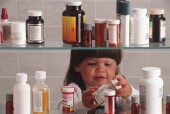
TUESDAY, Nov. 30 (HealthDay News) — The admonishment to parents to carefully follow the directions on the labels of over-the-counter kids’ medicines may be futile, new research suggests.
The study found that most of the popular cough-and-cold, pain-relieving, allergy and stomach drugs just don’t explain dosing very well to begin with. Nor is there much consistency in product labeling.
“Almost all the products had inconsistencies,” said Dr. H. Shonna Yin, lead author of an early-release study that will be published in the Dec. 15 print issue of the Journal of the American Medical Association.
Dr. Karen Wilson, assistant professor of pediatrics at the University of Rochester Medical Center in New York, found the results “shocking” and yet not altogether surprising.
“Having inconsistencies in the labeling of nonprescription medications that are being used with children obviously increases the likelihood of misdosing quite a bit,” she said. “But being a parent and a physician, I’ve known that dosing is not very easy to figure out.”
“This is a real issue,” added Dr. G. Randall Bond, medical director of the Cincinnati Drug and Poison Information Center at Cincinnati Children’s Hospital. “I think it will make a big difference if we can work toward the goals [the authors set out].”
But he also pointed out that while “a large number of emergency visits are related to [over-the-counter medications], very few of those are related to misdosing. Most of the time it’s kids who got into the medicine. That’s the real driver.”
The study comes almost exactly a year after the U.S. Food and Drug Administration (FDA) issued voluntary guidelines recommending that manufacturers of common over-the-counter medications be more consistent in their dosing directions and include measuring devices with the products, among other suggestions.
The Consumer Healthcare Products Association, which represents these manufacturers, also issued voluntary guidelines.
“This was after a number of reports of accidental overdoses attributed to issues around inconsistent and poor labeling,” said Yin, who is an assistant professor of pediatrics at NYU School of Medicine. “They don’t set specific mandates and don’t have a timeline for compliance so we wanted to document how big this problem is. Are voluntary guidelines all that are needed? We also wanted a baseline to see if products change.”
Parents make dosing errors about 50 percent of the time, Yin said.
While most of these improperly dosed ingestions aren’t serious, some, such as overdosing on acetaminophen, can lead to liver failure and death, Wilson said.
Yin and her colleagues looked at 200 liquid over-the-counter medications for kids under 12 sold in the year after the recommendations were issued. This represented 99 percent of all products out there.
About three-quarters of the products did include measuring devices but for 98.6 percent of those, what was stated on the directions didn’t match the markings on the spoon or cup.
These included needed markings that weren’t there or extra markings that weren’t necessary.
A little over 5 percent of the products used arcane measurements such as drams or cc’s. Sometimes abbreviations weren’t defined.
In addition to matching up instructions on the device and the label, Yin (and the FDA) recommend that uniform measurements be used, preferably milliliters, as even teaspoon and tablespoon are easily confused.
And given the scope of the problem, “we’re pretty concerned that voluntary guidelines won’t be able to fix the problem,” Yin said. “The FDA may need to set standards and regulate products.”
In the meantime, she said, parents should still pay attention to labels and, if they can’t understand what’s indicated (maybe because it doesn’t make sense), ask a doctor or a pharmacist.
More information
For more on over-the counter medications for children, head to the Federal Citizen Information Center.

